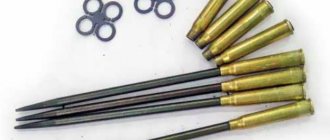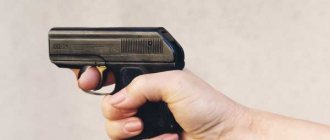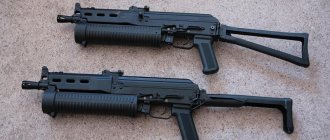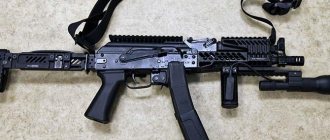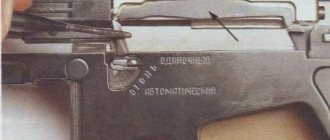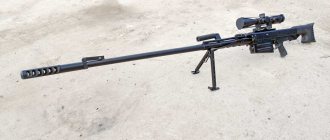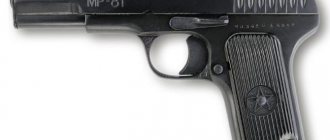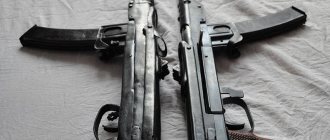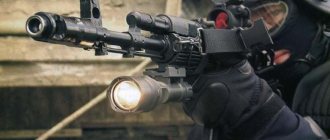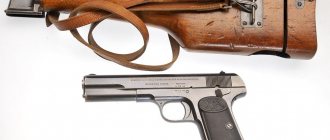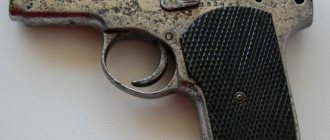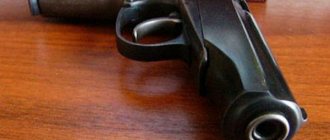The Stechkin automatic pistol is one of the legendary examples of the domestic arms industry.
Designed after the end of the Great Patriotic War, the Stechkin pistol was supposed to complement the Makarov pistol, which we recently told you about, with its functionality. These two “brothers” are still popular and in demand among security forces and law enforcement officers to this day.
But if the compact and unpretentious PM is more of an operational and service pistol, then Stechkin is a real “fighter”, large, heavy, with a large magazine, automatic fire and with a “trick” - a holster-butt. This pistol was designed to protect officers, intelligence officers, crews of armored vehicles - everyone who lacked the Makarov’s firepower for self-defense.
Over the years of service and operation, the APS, just like its “brother” PM, has acquired many myths, various true and not so true assessments. Today we will try to understand them and tell you the history of the world-famous domestic pistol.
History of creation
According to official data, the Stechkin APS automatic pistol was developed in 1948 at TsKB 14, and a prototype was provided the following year, 1949. Another story says that a student at the Tula Mechanical Institute, Igor Stechkin, while defending his diploma, presented the professor with a drawing of a new pistol with a 7.62 caliber.
Additionally, the young man showed a finished sample. In response, he received a statement that he would not be able to shoot - a blank shot at the ceiling convinced the professors of the opposite.
Working at TsKB 14 (today the Instrument Design Bureau), Igor Yakovlevich was engaged in the design of new modifications of weapons on behalf of the CPSU Party. Immediately after the approval of the created sample, the young genius received the task of converting it to a 9-mm caliber, with the possibility of single and automatic firing.
In addition, design was carried out in the following directions:
- Increased magazine capacity.
- The ability to conduct both single and automatic fire modes.
- Achieving the ability to conduct aimed fire at a distance of 200 m.
- Use the holster as a buttstock.
As a result, from 16.04 to 22.06. In 1949, he, together with the presented model, won the competition to select a new officer's weapon for the Armed Forces of the Soviet Union, ahead of such weapons geniuses of the time as Kalashnikov and Voevodin.
Design Features
The unique design of the magazine, in which the arrangement of 20 cartridges is not strictly horizontal like in any other, but in a checkerboard pattern, makes the chamber manufacturing procedure particularly complex.
It is worth emphasizing that the Stechkin pistol, which became legendary, remained the only one of its kind with such a magazine design.
Until today, no foreign manufacturer has used similar specifications. This emphasizes the uniqueness and individuality of the APS.
The safety lever located on the gate performs 2 functions simultaneously:
- The main one, de-cocking.
- Switches fire modes.
The first models of the APS pistol did not have chrome plating on the barrel, and also featured a different retarder bolt that worked on a different principle.
Specifications
The performance characteristics of the APS pistol are presented in the table:
| Caliber APS | 9mm |
| Weight without ammunition and holster | 1,002 g |
| Weight with ammunition and holster | 1,780 g |
| Rate of fire | 40/90 rounds per minute |
| Ammunition capacity | 20 rounds |
| Bullet speed at departure | 340m/s |
| Precision shooting | 200 m |
| Length | 225 mm |
| Height | 150 mm |
As can be seen from the given technical characteristics, the developer coped with the task and created a pistol capable of conducting aimed fire at a target located at a distance of 200 m.
Lethal bullet range up to 350 m.
Application
Igor Stechkin’s pistol was put into service in mid-1951.
Initially, it was intended for crews of tanks and other armored vehicles, gun crews, the first numbers of heavy machine guns and grenade launchers, naval officers, as well as officers of the border KGB.
The weapon was used for so-called personal protection.
There were no analogues in the accuracy of fire in relation to compactness in the whole world.
The weapon performed well during numerous military conflicts and wars in which the Soviet Union took part. He passed his first test in a shootout with Bandera and the “forest brothers,” the name of the group of separatists destroyed by security forces in 1958.
However, when performing ordinary peaceful service, it turned out to be inconvenient: the bulky and heavy holster for the Stechkin pistol constantly interfered with movement. It turned out that among its analogues it is too large, and in comparison with a submachine gun it has a short range.
This led to it being discontinued in 1959.
Unlike the Red Army, the special services (KGB, GRU) regularly used weapons created by Igor Yakovlevich.
The situation is explained as follows: Carrying a pistol for show turned out to be inconvenient, but in real combat it became indispensable.
The weapon received many flattering reviews in cases where it was not possible to use the AKS-74 assault rifle for fear of shooting through a wall and causing harm to the civilian population, and there was not enough PM and TT ammunition.
In this case, the most acceptable was the use of a modernized version of the APS pistol - APB, a rapid-fire, multi-shot and silent machine with a silencer.
During the First and Second Chechen Wars, weapons brought from long-term storage were issued to snipers and pilots. Today, many Ukrainian special services continue to use it: Berkut, Titan, Alpha.
Photo of the Stechkin pistol
Similar
AK-47 assault rifle cartridge caliber 7.62 mm.
Device. Rate of fire AK-74 assault rifle cartridge 5.45 mm caliber. Device. Rate of fire
Dragunov SVD sniper rifle caliber 7.62 mm. Device
AKS-74U assault rifle cartridge caliber 5.45 mm. Device. Weight
Mauser K96 pistol cartridge caliber 7.63 and 9 mm. Device
Pistol Walter PP / PPK cartridge caliber 7.65 and 9 mm. Device
Pistol Yarygin PYa Grach cartridge caliber 9 mm. Device
DShK machine gun cartridge caliber 12.7 mm. Device. Rate of fire
Luger pistol R.08 Parabellum cartridge caliber 9 mm. Device
Pistol PM cartridge caliber 9 mm. Rate of fire. Dimensions. Bullet speed. Sighting range
Self-loading shotgun Saiga-12 cartridge, caliber. Device
Maxim machine gun cartridge caliber 7.62 mm. Device. Weight
PPSh-41 Shpagina submachine gun cartridge caliber 7.62 mm
APS Stechkin pistol cartridge caliber 9 mm. Device
Nagan system revolver cartridge caliber 7.62 mm. Device
Kalashnikov PK machine gun and PKM cartridge caliber 7.62 mm. Device
Simonov carbine SKS-45 cartridge caliber 7.62 mm. Device
Rifles and carbines Mauser 98 caliber 7.92 mm. Device
PPS-42 and PPS-43 Sudaev submachine gun cartridge caliber 7.62 mm
Pistol Walter P38 cartridge caliber 9 mm. Device
MP-40 German submachine gun cartridge caliber 9 mm. Device
VSS Vintorez sniper rifle caliber 9 mm. Device
Submachine gun PP-91 Kedr cartridge 9 mm caliber. Device
Light machine gun RPK-74 cartridge caliber 5.45 mm. Device
Pistol Glock 17 cartridge caliber 9 mm. Device
Makarych, Izh-79-9T, MR-79-9TM, MP-80-13T traumatic pistol
AK-12 assault rifle cartridge caliber 5.45 mm. Device. Weight
Mosin rifles and carbines Three-line caliber 7.62 mm
PMM Makarov pistol modernized 12 rounds. Device
Revolver Colt Single Action Army (SAA) Peacemaker. Device
Machine gun PKP Pecheneg cartridge caliber 7.62 mm. Device
Sniper rifle VSSK Exhaust caliber 12.7 mm. Device
Beretta pistol 92 cartridge caliber 9 mm. Device
TT - Tokarev pistol cartridge caliber 7.62 mm. Device
Submachine gun PP-19 Bison cartridge caliber 9 and 7.62 mm. Device
Sniper rifle SV-98 caliber 7.62 mm. Device
Vladimirov KPV machine gun cartridge caliber 14.5 mm. Device
ASH-12 assault rifle cartridge caliber 12.7 mm. Device. Rate of fire
PSM pistol cartridge caliber 5.45 mm. Device
Pistol Colt M1911A1 cartridge caliber 45. Device
Smith-Wesson revolver Russian cartridge, caliber 10.67 mm. Device
Degtyarev DP-27 light machine gun, 7.62 mm caliber cartridge. Device
Shotgun Mossberg 500 Cartridge. Dimensions. Rate of fire. Sighting range
Thompson submachine gun cartridge caliber 11.43 mm. Device
Pistol USP Heckler und Koch cartridge, caliber. Device
Hunting carbine OSK-88 (SVT-40) caliber 7.62 mm. Device
AS Val silent automatic cartridge caliber 9 mm. Device
Submachine gun PP-19-01 Vityaz cartridge 9 mm caliber. Device
Machine gun Kord cartridge caliber 12.7 mm. Device. Weight. Sighting range
Osa - traumatic pistol cartridge, caliber. Device
AK-9 assault rifle cartridge caliber 9 mm. Device. Rate of fire
Degtyarev RPD light machine gun, 7.62 mm caliber cartridge. Device
Automatic OTs-14 Groza cartridge caliber 9 mm and 7.62 mm. Device
Czech pistol CZ-75 (modifications). Device
Browning pistol 1903 cartridge caliber 9 mm. Device
Sniper rifle OSV-96 caliber 12.7 mm. Device
FN P90 submachine gun cartridge caliber 5.7 mm. Device
Submachine gun OTs-02 Cypress cartridge caliber 9 mm. Device
Sniper rifle ASVK Kord caliber 12.7 mm. Device
Automatic AEK-971 Cartridge. Caliber. Device. Rate of fire
Steyr AUG assault rifle (A1, A2, A3) cartridge caliber 5.56 mm
AK series 100 assault rifles. Modifications. Device. Weight. Dimensions
Uzi submachine gun. Cartridge. Caliber. Rate of fire
Pistol SR1M Gyurza cartridge caliber 9 mm. Device
Pistol GSh-18 cartridge caliber 9 mm. Device
SVDK sniper rifle caliber 9.3 mm. Device
Automatic SR-3M Whirlwind cartridge caliber 9 mm. Device
Machine gun NSV-12.7 Utes cartridge, cal. Device. Weight
Kalashnikov RPK light machine gun cartridge caliber 7.62 mm. Device
Sniper rifle VSK-94 caliber 9 mm. Device
Vostok-1 (Jorge-3M) 9mm caliber traumatic pistol. Device
Degtyarev PPD submachine gun cartridge caliber 7.62 mm
English sniper rifle L96A1 cartridge, caliber
M1 Garand rifle cartridge caliber 7.62 mm. Device
Desert Eagle pistol. Device
Smith-Wesson revolver (modifications). Device
Automatic rifle HK G36 (E, K, C, KE) cartridge caliber 5.56 mm
Pistol P-96 cartridge caliber 9 mm. Device. Rate of fire
Pistol GP35 Browning High Power cartridge, caliber. Device
Assault rifle FN SCAR (L, H) cartridge caliber 5.56 and 7.62 mm
Revolver Lefoshe M1856 cartridge caliber 11 mm. Device
Submachine gun PP-90 cartridge caliber 9 mm. Device
AN-94 Abakan automatic Nikonov cartridge caliber 5.45 mm. Device
Submachine gun PP-2000 cartridge caliber 9 mm. Device
Mauser pistol HSc cartridge caliber 7.65 and 9 mm. Device
M16 automatic rifle cartridge caliber 5.56 mm. Device
Fedorov assault rifle cartridge caliber 6.5 mm. Device. Rate of fire
Pistol Baltiets cartridge caliber 7.62 mm. Device
Strizh pistol cartridge caliber 9 mm. Device. Weight. Sighting range
Browning pistol 1910 cartridge caliber 7.65 and 9 mm
Silent pistol PSS Vul cartridge caliber 7.62 mm. Device
Pistol SIG-Sauer P226 cartridge caliber 9 mm. Device
Pistol OTs-27 Berdysh cartridge caliber 7.62 mm and 9 mm. Device
AK-107 assault rifle cartridge caliber 5.45 mm. Device. Rate of fire
OTs-44 sniper rifle, caliber 12.7 mm. Device
German machine gun MG3 cartridge caliber 7.62 mm. Device
Self-loading shotgun Browning Auto-5 cartridge, caliber. Device
Submachine gun AEK-919K Kashtan cartridge caliber 9 mm. Device
PB pistol silent cartridge 9 mm caliber. Device
Pistol OTs-33 Pernach cartridge caliber 9 mm. Device
Hunting carbine KO-98 cartridge caliber 7.92 mm. Device
TK (Korovin pistol) caliber 6.35 mm. Device. Weight. Dimensions
Underwater assault rifle APS cartridge caliber 5.66 mm. Device
Pistol OTs-21 Malysh cartridge caliber 9 mm. Device
American M60 machine gun, 7.62 mm caliber cartridge. Device
MTs-116M sniper rifle, caliber 7.62 mm. Device
Automatic 9A-91 cartridge caliber 9 mm. Device. Rate of fire
Submachine gun PP-93 cartridge caliber 9 mm. Device
VAG-73 - Gerasimenko pistol. Device. Weight. Dimensions
Cordon-5 is a traumatic pistol. Device. Weight. Dimensions
Goryunov SG-43 heavy machine gun cartridge caliber 7.62 mm. Device
Webley revolver cartridge, caliber. Device. Dimensions. Weight
Machine gun AEK-999 Badger cartridge caliber 7.62 mm. Device
RP-46 machine gun, 7.62 mm caliber cartridge. Device. Rate of fire
Sniper rifle VS-8 cartridge caliber 8.6 mm. Device
Slostin machine gun cartridge caliber 7.62 mm and 14.5 mm. Device
Assault rifle Tavor TAR-21 cartridge caliber 5.56 and 5.45 mm
Submachine gun SR-2 Veresk cartridge caliber 9 mm. Device
Lancaster pistol cartridge caliber 12.1 mm. Device. Rate of fire
Submachine gun PP-90M1 cartridge caliber 9 mm. Device
Underwater pistol SPP-1M. Device. Weight. Dimensions
Traumatic pistol MP-461 Guard. Device. Weight. Dimensions
Lebel rifles and carbines are cartridgeed in 8 mm caliber. Device
Automatic A-91 cartridge caliber 7.62 mm. Device. Rate of fire
M14 automatic rifle cartridge caliber 7.62 mm. Device
Revolver Smith & Wesson Model 10 Military & Police
Automatic rifle FN FAL cartridge caliber 7.62 mm. Device
Submachine gun STEN MK 2. Device. Weight. Dimensions
Traumatic pistol IZH-78-9T Chain mail cartridge caliber 9 mm
Leader-M traumatic pistol 11.43×32T. Device. Weight. Dimensions
Ingram M10 and M11 submachine gun. Device. Weight. Dimensions
Pistol Steyr M9-A1 cartridge caliber 9 mm. Device. Weight
Pistol OTs-23 Dart cartridge caliber 5.45 mm. Device
Berthier rifles and carbines caliber 8 mm. Device
Automatic shotgun USAS-12 cartridge caliber 18.5 mm
Sniper rifle VS-121 caliber 7.62 mm. Device
Traumatic pistol MP-353 cartridge, caliber 11.43 mm
Tiss machine gun cartridge caliber 9 mm. Device. Rate of fire
Traumatic pistol MP-355 cartridge caliber 9 mm. Device
Automatic double-medium ADS cartridge caliber 5.45 mm. Device. Rate of fire
Traumatic pistol MP-81 cartridge caliber 9 mm. Device
Pistols Zastava 70 and 70(k), cartridge caliber 7.65 or 9 mm. Yugoslavia
Sniper rifle GALATZ (Galil) cartridge caliber 7.62 mm
Pistol MP-444 Bagheera cartridge caliber 9 mm. Device
Revolver Colt New Army / Navy. Device. Bullet speed. Sighting range
Type 64 is a Japanese automatic rifle. Device
Comments
0 Vadym Zinkivskiy 01/31/2017 15:35 The gun is good. The recoil is softer than that of the PM. The bakelite holster is in place. With the holster attached it's a good pile. With improvements and cheaper production, it could be kept in service further. Replacing APS with Bastard was a mistake.
Reply | Reply with quote | Quote
0 Evgeny Fedorov 01/31/2017 15:38 In my opinion, Stechkins are now only with the Febers, who supervise the military units, sort of NKVD officers. But ordinary officers don’t have them, I think there’s only 1 unit for the whole battalion, so it’s rare, and the holster is tough. For me, it would be better if they were given a GS instead of Stechkin, and the Kalash will always be better than any pistol in long-range shooting, so Stechkin’s holster is ridiculous. If they had made a mechanical folding buttstock instead of this holster, it would have been much more convenient, but in the USSR the last thing they thought about was convenience.
officers. But ordinary officers don’t have them, I think there’s only 1 unit for the whole battalion, so it’s rare, and the holster is tough. For me, it would be better if they were given a GS instead of Stechkin, and the Kalash will always be better than any pistol in long-range shooting, so Stechkin’s holster is ridiculous. If they had made a mechanical folding buttstock instead of this holster, it would have been much more convenient, but in the USSR the last thing they thought about was convenience.
Reply | Reply with quote | Quote
0 Oleg Dub 01/31/2017 16:18 The bullet in the 9 Pst gzh (gs, gl) (57-N-181S) cartridge has a steel core. These cartridges are used in the army. By the way, in the Manual on Shooting for the PM, it is the cartridge with a steel core that is described. Interestingly, the NSD for the APS describes a cartridge with a bullet without a core. I didn't have any of these in my warehouse.
Reply | Reply with quote | Quote
0 vechniy 01/31/2017 16:20 I was always surprised why Stechkin used such a weak cartridge? It seems to me that if he had taken the 7.62-25 from the TT, the history of the APS would have turned out differently. And the lack of stopping power could be compensated for by the shape and material of the bullet.
Reply | Reply with quote | Quote
0 Slava Malcev 01/31/2017 16:21 I quote vechniy:
I always wondered why Stechkin used such a weak cartridge? It seems to me that if he had taken the 7.62-25 from the TT, the history of the APS would have turned out differently. And the lack of stopping power could be compensated for by the shape and material of the bullet.
Under the 7.62×25 cartridge, Stechkin would have been crazy about making a LOCKING MECHANISM for the chamber, this is an insane complication and a significant reduction in the reliability of the pistol.
It is impossible to make a pistol chambered for the TT cartridge with a blowback action. Therefore, Stechkin took the easy path, and he simply could not use another cartridge. Reply | Reply with quote | Quote -1 DenX-GOD 01/31/2017 16:23 It’s a good pistol, and those who shout that it’s bullshit are either pro-Americans or sofa special forces))), and the barrel is good, not universal, but good
Reply | Reply with quote | Quote
0 Reception Radar 01/31/2017 16:25 I like Stechkin, both in appearance and in characteristics. Of course, a kilo is a bit heavy, but this is not the last century, you can replace it with lighter material.
Reply | Reply with quote | Quote
0 OoohWaa 01/31/2017 16:25 I quote Radar Reception:
I like Stechkin, both in appearance and in characteristics. Of course, a kilo is a bit heavy, but this is not the last century, you can replace it with lighter material.
heaviness is reliability.
Even if he doesn’t shoot, you can always hit him in the head. Reply | Reply with quote | Quote 0 Sasha Baron 01/31/2017 16:30 if it were really that good, it would have more use, but practice is the criterion of truth, that’s what they write on the websites of which it is difficult to accuse of idolatry to the West. However, the use of the pistol in the army revealed a number of shortcomings - the inconvenience of wearing a massive holster-butt, the large dimensions of the weapon and the impracticality of automatic fire, as well as the handle with a small angle of inclination takes some time to get used to and is not suitable for “instinctive” shooting at the side. Most officers considered this pistol to be overly large and uncomfortable for everyday carry, especially in peacetime conditions. As a result, the APS was withdrawn from production and service. As a result, in the 1960s, the bulk of Stechkin pistols ended up in warehouses. But at the same time, the APS, which has better shooting accuracy, less recoil, less barrel bounce when firing and much greater firepower than the PM, continued to be used by the KGB of the USSR and was supplied to various friendly countries. for comparison, Browning High-Power (HP) has been produced since 1935 to this day, unlike Stechkin with its ... unconvincing production period of 7 years
Reply | Reply with quote | Quote
0 Nikola Rosada 01/31/2017 16:31 I quote Sasha Baron:
if it were really so good, it would have more use, but practice is the criterion of truth, this is what they write on the sites of which it is difficult to accuse of idolatry of the West. However, the use of the pistol in the army revealed a number of shortcomings - the inconvenience of wearing a massive holster-butt, the large dimensions of the weapon and the impracticality of automatic fire, as well as the handle with a small angle of inclination takes some time to get used to and is not very suitable for “instinctive” shooting at the side. Most officers considered this pistol to be overly large and uncomfortable for everyday carry, especially in peacetime conditions. As a result, the APS was withdrawn from production and service. As a result, in the 1960s, the bulk of Stechkin pistols ended up in warehouses. But at the same time, the APS, which has better shooting accuracy, less recoil, less barrel bounce when firing and much greater firepower than the PM, continued to be used by the KGB of the USSR and was supplied to various friendly countries. for comparison, Browning High-Power (HP) has been produced since 1935 to this day, unlike Stechkin with its ... unconvincing production period of 7 years
If you were to compare the Browning High-Power (HP) with a TT, PM, Mauser, Walther Parabellum pistol, it would be somehow, well, at least fair, since their tasks were the same, but these are completely different weapons, and the tasks are different.
Following your logic, a passenger car is better than a truck, it’s much more comfortable to drive, and it consumes less fuel. Reply | Reply with quote | Quote 0 Sasha Baron 01/31/2017 16:32 What? This is a personal weapon, what other tasks does Stechkin have? Does it have better armor penetration than the PM? That’s why Stechkin was removed, that there is no point in having two pistols with the same capabilities, the PM is alive, Stechkin merged, shooting bursts from a weapon with a blowback from the hand is nonsense, but holding it with two hands + butt, it’s easier and more correct to make a submachine gun, not this shit neither here nor there
Reply | Reply with quote | Quote
0 Ivan Ivanovich 01/31/2017 16:33 Sasha Baron is a soldier’s pistol, a fool, mass-produced and cheap. used if there is no Kalash at hand. Why does he need convenience? for officers there was always a pm that could be put in a trouser pocket
Reply | Reply with quote | Quote
0 Sasha Baron 01/31/2017 16:35 I quote Ivan Ivanovich:
Sasha Baron is a soldier’s pistol, a fool, mass-produced and cheap. used if there is no Kalash at hand. Why does he need convenience? for officers there was always a pm that could be put in a trouser pocket
APS, was never a soldier.
And in general, soldiers are not supposed to have a gun, uncle. As for the APS, it is unfinished. It's generally inconvenient to shoot in bursts. After the second shot, the barrel lifts up. Either it's the 32nd Glock!!! What a machine! Reply | Reply with quote | Quote 0 Oleg Nikolaev 01/31/2017 16:37 Well done pistol. Don't you think that in the Soviet Union there were idiots who did not allow a bad pistol to be sold abroad? When I served, only special forces had a Stechkin pistol and the Makarov was not up to par. There was simply no one to bring it to him. Maybe it seemed heavy to Brezhnev. And there is no need to spread rot on the best. What kind of Beretta? Don't compare the cart with the Lada
Reply | Reply with quote | Quote
0 Alex Paul 01/31/2017 16:42 But everyone who has used it says it’s good. And for 1951 it’s completely unique. The next pistol with similar characteristics will appear only 27 years later (HK VP70) and will also not find recognition. Comparing it with an ultrasound or similar is like comparing an AK47 with a Fauspatron. Completely different purposes, you can’t put an ultrasound in a holster. The USSR simply did not need Stechkin, due to the fact that the USSR did not participate in any major conflicts at that time. It was created in case of a war similar to the Second World War. For example, the Colt 1911 was inferior to the APS in everything. It was heavier, more complex, more expensive, had three times less ammunition (7 versus 20), and had greater recoil. If such a weapon appeared in the states, it would instantly conquer the market.
Reply | Reply with quote | Quote
-1 goga 07/20/2017 09:21 guys, well, let's equate Faust cartridges with a needle, time goes by fps my friends saved more than one life and you are still talking about the same thing. I used scorpions for 5 years, two at a time, and a magnum 44 on missions in Afghanistan, and as a reward they gave me one when I went to Angola with a personal name
Reply | Reply with quote | Quote
Update list of comments
Options and modifications
Despite the fact that such weapons were initially received negatively due to their size, they are still in service with some special services. There are only 2 combat models.
Silent
APB - with a silencer, adopted for service in 1972.
Stechkin’s pistol colleague Neugodov A.S. developed a unique mechanism that absorbs the sound of a shot, which is still used today.
To do this, it was necessary to change the design of the weapon itself, since the silencer covers the line of sight. It was decided to move the muzzle hole lower and develop a mechanism connecting the two resulting products into one.
The created model is distinguished by increased accuracy during automatic shooting, since the weight of the barrel has increased, which has reduced its recoil at the moment of firing.
However, the weapon has become even heavier and bulkier, and now before the start of the battle it is necessary to attach a silencer, which takes precious seconds.
Pneumatic
The APS NBB pistol is manufactured by the American company Gletcher, and shoots 4.5 mm caliber balls. This option is completely reminiscent of the original version, the difference is in weight, the American is lighter (aluminum alloy was used for the manufacture of some components).
In all other respects, it corresponds to the combat one, even the procedure for detaching the magazine is identical.
A modification of the APS M air pistol is available in 2 types. The first has a fixed shutter, the second has a “blow-back” mechanism that imitates its operation.
You can buy any of the pneumatic modifications in specialized stores. No registration or permits are required.
Trauma
The traumatic model is called the Stechkin APS M pistol, although it is impossible to fire live ammunition from it. Instead of a barrel, there is an imitation barrel.
The chamber is also weakened. Many parts were removed, some were trimmed so that conversion into a combat pistol was impossible. The magazine has been reduced to 10 rounds. The cartridges in this rubber arrow are 10x22T. For reference, in combat Stechkin it is 9x18 mm.
The muzzle energy of a rubber “bullet” squeezed out through an imitation barrel is no more than 50 J, usually 30, depending on the cartridge manufacturer. Whereas the energy of a combat pistol bullet is 350 J.
Although the original holster was used with the model, the injury was not popular due to its size. Production of the APS M pistol ceased in 2011.
Existing disadvantages
But still, despite the important advantages, readily recognized by many weapons experts, the characteristics of Stechkin, whose photo the reader sees in the article, also became the cause of certain shortcomings.
One of the most noticeable is the weight, as mentioned above. Few people would like to carry a holster on their side with a pistol that weighs a kilogram, and four more fully loaded magazines, weighing about 800 grams in total. And in general, the large dimensions caused some inconvenience when wearing and using.
The disadvantage is the relatively low power - the fault of this is not the design of the pistol, but the cartridge used. Still, the Stechkin caliber cannot provide serious penetrating power.
These two shortcomings have proven to be very important for different users. For example, for the military, who may need to use weapons in combat in open space, the pistol turned out to be too weak. But for law enforcement officers it had too much weight and dimensions - it was impossible to carry it covertly, and the holster with a pistol and magazines, weighing 2.5 kilograms, did not add comfort.
As a result, it was decided to stop production of the Stechkin pistol, giving preference to the analogue created by Makarov. In addition, the Modern competition was announced in the 1970s. His main task was to create a small-sized assault rifle that would use 5.45x39 mm ammunition and could completely replace the Stechkin pistol. As a result, the victory went to the AKS-74U assault rifle.
However, the successful pistol was not forgotten at all. Already in the 1990s, several types of weapons based on it were developed and put into production: OTs-23 “Dart”, OTs-27 “Berdysh” and OTs-33 “Pernach”.
Assembly and disassembly
Disassembly of the APS is required only for cleaning it or replacing faulty parts.
At the same time, for prevention, the disassembly procedure is much simpler than that of the legendary Makarov pistol.
Incomplete
Partial disassembly of the gun for the purpose of cleaning and lubricating the mechanisms is carried out as follows:
- The magazine is removed from the handle.
- The shutter and frame are separated from each other.
- The return spring is removed from the barrel.
The assembly procedure is carried out in the reverse order of removal.
Full
A complete disassembly of the APS is necessary in the event of replacing parts that have become unusable, or if the weapon gets into water or dirt. It is recommended to carry out this at the time of transition to a new lubricant.
The steps required for this are as follows:
- The actions necessary for partial disassembly are performed.
- The trigger guard returns to its place.
- The trigger is removed from the cocking position.
- Both cheeks on the handle are separated.
- The transmission lever is removed by pressing the retarder.
- The sear comes off.
- Removing the spring with moderator and rod.
- The magazine latch is removed with a pusher and mainspring.
- Pull back the trigger rod and disconnect the trigger.
- Remove the trigger guard from the frame.
- Separate the trigger from the trigger rod.
- Removing the translator-fuse from the bolt part.
- Disconnect the firing pin from the bolt part.
- By lifting the rear end of the ejector, disconnect it from the bolt part.
- Remove and disassemble the magazine.
Assembly is carried out in reverse order.
During his further work, Igor Yakovlevich created many well-known modifications of small arms that are still used today. This is a Stechkin revolver, the first domestic revolver with a folding cylinder and a double-action trigger mechanism.
The “Dart” pistol was developed, which allows you to fire single shots and bursts of 3. The automatic “Pernach”, which replaced the APS and surpasses it in many characteristics. As well as the Berdysh pistol and much more.
AND I. Stechkin made a contribution to domestic armament that cannot be measured in either material or spiritual terms. This is a genius whose work will be used by more generations of designers.
Advantages
Compared to the Makarov pistol, the APS provided significantly greater firepower and combat effectiveness due to its larger magazine capacity and longer barrel. In addition, to increase shooting accuracy, a holster-butt attached to the handle was attached to the pistol. If necessary, it was also possible to fire from the APS not only with single shots, but also with bursts. At the same time, thanks to the presence of a rate of fire retarder, the pistol remained quite controllable. The shot sound was quieter than the PM (thanks to the longer barrel and optimal internal ballistics).
The weapon has high operational reliability, tested in difficult operating conditions, and subsequently in combat. The pistol has high shooting accuracy, despite the use of a cartridge with low ballistic qualities and a small angle of inclination of the handle. One of the main advantages is low recoil and very little bounce of the weapon when fired. This quality, combined with high (for such a weapon) accuracy, allows high-speed shooting with single shots with a large accuracy of hits.
This advantage is especially important for close combat. At the same time, cartridge consumption is also controlled
Thanks to the simplicity of the design, the APS is easy to maintain. This weapon has a significant margin of safety. Some pistols have been fired for about 40,000 rounds without cracks on the bolt casing or other serious damage.
